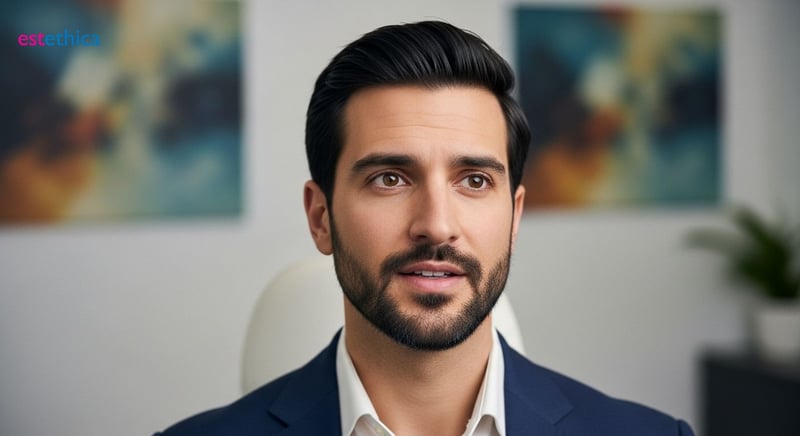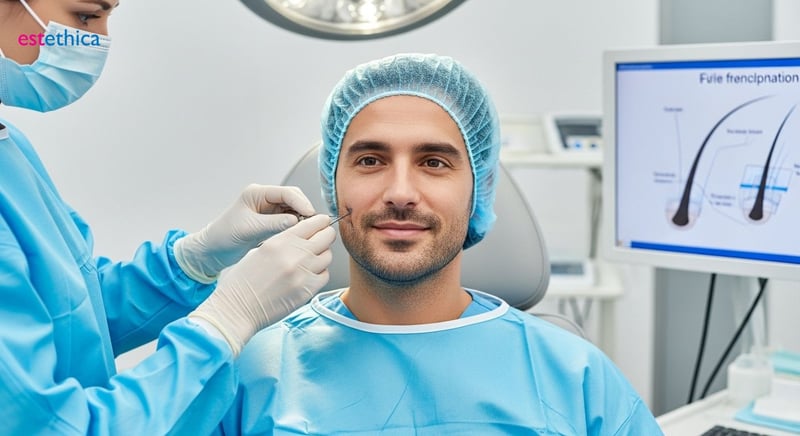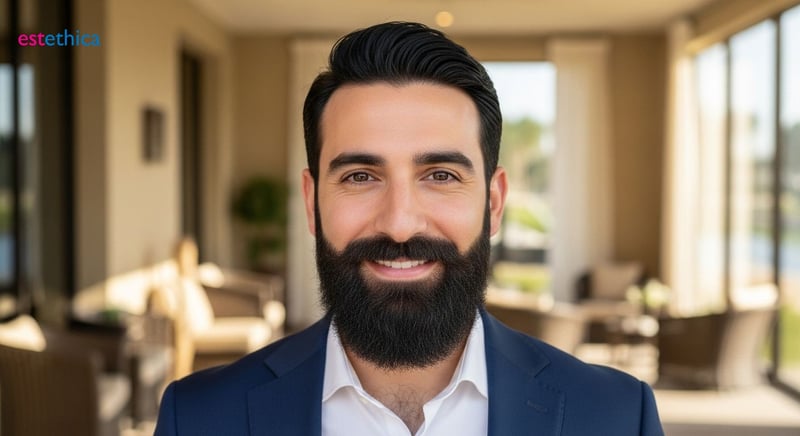Beard Transplant: Achieve a Fuller, Natural Look
Explore beard transplant services for a fuller, natural look. Learn about full beard transplant surgery, best results, and permanent facial hair restoration.
Full Beard Transplant Surgery Explained
A full beard transplant surgery is a sophisticated procedure designed to create a complete and dense beard, offering a significant aesthetic enhancement. It involves meticulously transplanting individual hair follicles, typically sourced from the scalp, to targeted areas on the face where beard growth is sparse or absent. The core objective is to achieve results that are indistinguishable from natural beard growth, paying close attention to the precise angle, direction, and density required for each transplanted graft. Specialists carefully select donor hair that closely matches the existing beard's texture and color, ensuring seamless integration and a completely natural appearance. This transformative surgery is an ideal solution for individuals seeking a comprehensive answer to concerns ranging from patchy growth to complete absence of facial hair, providing a lasting solution.
The Procedure and Techniques
During the procedure, surgeons often employ advanced techniques such as Follicular Unit Transplantation (FUT) or, more commonly for facial hair, Follicular Unit Extraction (FUE). The FUE method is frequently preferred for its minimally invasive nature, resulting in less noticeable scarring compared to other methods. This technique involves extracting individual follicular units from the donor area and then creating tiny incisions in the recipient facial zones. These grafts are then strategically placed to ensure the most aesthetic and natural-looking outcome possible. The careful placement guarantees that the transplanted hairs grow in the correct direction, mimicking the pattern of a natural beard. This advanced approach ensures that the final result looks authentic and enhances the overall facial aesthetics.
The journey to a fuller beard often begins with understanding the nuances of this procedure. For those curious about achieving a more robust appearance, exploring resources like Beard Transplant: Achieve Fuller, Natural Facial Hair can provide valuable insights into the process and potential outcomes. Recovery times for a beard transplant can vary, but most individuals can resume their normal daily activities relatively quickly. Within a few months post-surgery, the transplanted hairs will begin to grow, gradually thickening and integrating with the existing facial hair. This procedure, often referred to as sakal ekimi in Turkish, is a popular choice for many seeking enhanced masculinity and self-confidence through improved beard coverage. The effectiveness of sakal ekimi lies in its ability to permanently address hair loss in the beard area.

Best Beard Transplant Results: What to Expect
Achieving the best beard transplant results hinges on a combination of expert surgical technique, careful planning, and realistic expectations. The ultimate goal of a sakal ekimi procedure is to achieve an outcome that looks entirely natural, with transplanted hairs indistinguishable from your native growth. Patients can anticipate a gradual thickening and enhancement of their facial hair over several months as the implanted hair follicles mature and begin their growth cycle. The success of your beard transplant is measured not just by the achieved density but by the uniformity of the growth, the correct angling and direction of hair emergence that mimics natural patterns, and the overall aesthetic harmony with your facial structure.
A truly successful beard transplant procedure results in a beard that appears to have grown naturally over time, enhancing your individual features without any tell-tale signs of artificiality. This detailed approach ensures that the final look is seamlessly integrated, boosting confidence and providing the desired aesthetic improvement. For those considering this transformative procedure, understanding the journey is key. You can find more in-depth information about the process and what it entails in our article, Beard Transplant: Your Path to Fuller Facial Hair.
The Journey to Your New Beard
To ensure optimal outcomes, it's crucial to select a reputable clinic with experienced surgeons specializing in facial hair restoration. The surgeon's skill in donor hair harvesting and meticulous placement of each graft is paramount. They will carefully consider the angles, density, and natural flow required to create a believable and attractive result. Post-operative care also plays a vital role in the success of your full beard transplant surgery. Following the surgeon's instructions meticulously regarding gentle washing of the transplanted area, avoiding direct sun exposure, and refraining from strenuous activities that could disrupt the grafts is essential during the initial healing phase.
Patience and Long-Term Results
The permanence of the results is a significant benefit of undergoing a full beard transplant surgery, offering a long-term solution for individuals seeking enhanced beard density and a more defined facial profile. However, patience is key. The final, most impressive results typically become fully evident over a period of 12 to 18 months. During this time, the transplanted hairs will shed and then regrow thicker and stronger, gradually filling out the desired areas. Embracing this timeline allows for the full realization of the natural-looking enhancement you seek.
Natural Looking Beard Transplant Techniques
Replicating Natural Growth Patterns
Achieving a genuinely natural look in a beard transplant is an intricate process that hinges on mastering specific techniques. The fundamental objective is to meticulously replicate the unique growth characteristics of genuine facial hair. This necessitates a deep understanding of the precise angles and directional patterns that beard hairs follow across different facial zones, including the chin, cheeks, and jawline. Modern advancements, particularly with the Follicular Unit Extraction (FUE) method, allow for the precise harvesting and implantation of individual hair follicles. This granular control empowers surgeons to artfully design the beard's hairline and effectively fill in areas of sparseness with exceptional accuracy. The outcome of this detailed approach is transplanted hair that integrates seamlessly with existing growth, rendering the results virtually indistinguishable from natural hair.
Selecting Donor Hair and Achieving Optimal Density
The caliber of hair follicles chosen from the donor area plays a pivotal role in the success of the procedure. Ideally, donor hair should closely match the existing beard's texture and thickness for the most harmonious integration. Equally important is the achieved density; implanting an excessive number of follicles can lead to an artificial appearance, whereas insufficient density may not meet the patient's aesthetic goals. Therefore, a seasoned surgeon must expertly balance density, growth direction, and the natural flow of hair to create a result that accentuates, rather than overwhelms, the patient's unique facial features. This sophisticated approach to facial hair restoration prioritizes subtlety and realism.
The careful consideration of these elements is what distinguishes a superior sakal ekimi procedure. When performed with an artistic eye and technical precision, a full beard transplant surgery can dramatically enhance one's appearance. The goal is not just to add hair, but to craft a beard that looks and feels authentic, boosting confidence and refining facial aesthetics. For those considering this transformative procedure, understanding these techniques underscores the importance of choosing a skilled and experienced surgeon.

Facial Hair Restoration with Hair Follicles for Beard
Facial hair restoration, specifically focusing on enhancing the beard, is a sophisticated surgical procedure designed to imbue your face with a fuller, more aesthetically pleasing appearance. This technique is particularly effective for addressing concerns such as sparse beard growth, bald patches resulting from genetics or illness, or gaps created by injuries. The ultimate goal of sakal ekimi is to achieve the most natural-looking and enduring results possible. At its core, this procedure involves the meticulous transplantation of healthy hair follicles. These potent follicular units are typically sourced from the back or sides of the scalp, areas known for providing robust and resilient hair that maintains its original growth characteristics even when moved to the facial region. The process is precise, involving the extraction of these follicular units followed by their careful implantation into minuscule incisions meticulously made within the recipient beard area.
The Science Behind Follicular Unit Transplantation
The success of a beard transplant hinges on the strategic placement of each individual hair follicle. Experienced surgeons dedicate significant time to mapping out the recipient zone, ensuring that the angle, direction, and density of the transplanted hairs mimic natural growth patterns, thereby creating a convincingly natural look. The number of hair follicles required for any given procedure can vary considerably, directly influenced by the desired level of thickness and the total surface area designated for treatment. This advanced method offers a permanent solution for individuals experiencing patchy beards or a complete absence of facial hair. For those seeking a more comprehensive understanding of the methodology, exploring resources like "Mastering Beard Transplants: Your Guide to Facial Hair Restoration" can provide deeper insights into how does beard transplant work and its potential benefits.
The artistry and scientific precision involved in this type of beard transplant ensure that the transplanted hair grows naturally alongside existing facial hair. This technique represents a significant advancement in cosmetic procedures, offering individuals a reliable path toward achieving their desired beard aesthetics. The commitment to detail in every step of the sakal ekimi process, from donor site selection to the final implantation, underscores its efficacy. It’s a testament to modern surgical capabilities that such a natural and lasting enhancement to one's appearance is achievable through a full beard transplant surgery.
The expectation for a successful full beard transplant surgery is not just about adding hair, but about creating a harmonious and natural-looking facial profile. Patients often report a significant boost in confidence following the procedure, as it effectively addresses the aesthetic concerns associated with uneven or sparse facial hair growth. The permanence of the transplanted follicles means that individuals can enjoy their enhanced beard for years to come, making it a worthwhile investment for many.

Mastering Natural Beard Growth with Advanced Follicular Transplantation
The expertise in beard transplantation lies in meticulously transplanting individual hair follicles, typically sourced from the scalp, to targeted areas on the face. This process aims to create a complete and dense beard, offering a significant aesthetic enhancement by addressing sparse patches or complete absence of growth.
Modern techniques like Follicular Unit Extraction (FUE) are employed to ensure that the transplanted hair integrates seamlessly, closely matching the existing beard's texture and color for a natural look.
Specialists in facial hair restoration possess a deep understanding of aesthetic principles and surgical precision, crucial for replicating natural growth patterns. This includes careful consideration of the precise angle, direction, and density required for each transplanted graft to achieve the desired, undetectable results.
A Comprehensive Guide to Permanent Beard Restoration for a Fuller Look
A full beard transplant surgery is a sophisticated procedure designed to create a complete and dense beard, offering a significant aesthetic enhancement. This permanent solution is tailored to your unique facial structure, ensuring natural-looking results that boost confidence and address concerns like sparse growth.
Facial hair restoration, specifically focusing on enhancing the beard, is a sophisticated surgical procedure designed to imbue your face with a fuller, more aesthetically pleasing appearance, correcting issues like sakal seyrekliği (beard sparseness) or post-trauma gaps with the goal of the most natural results.
Understanding what is beard transplant surgery and exploring the latest beard transplant techniques empower individuals to make informed decisions about achieving their desired look. The procedure is often permanent, providing a lasting solution for those seeking enhanced facial hair density and a defined beard.
Exploring the best beard restoration options involves understanding facial hair restoration with hair follicles for beard, ensuring that the outcomes are not only dense but also blend harmoniously with your existing features, leading to a naturally fuller beard.